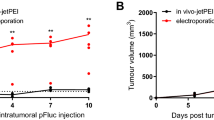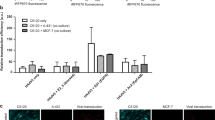Abstract
Systemic application of surface-shielded transferrin-polyethylenimine/DNA complexes leads to predominant DNA uptake and gene expression in Neuro2a tumors in syngeneic A/J mice. Similarly, high expression levels were found in Huh-7 and HepG2 human tumor xenografts in SCID mice after systemic application of surface-shielded EGF-PEG-PEI/DNA complexes. Significant DNA uptake but low gene expression were found in the M-3 melanoma while no DNA uptake and no gene expression were found in KB, 518A2, A549, and SW480 xenograft tumor models. To elucidate the reasons for these differences, the tumors were analyzed for vascularization and infiltration of macrophages. Neuro2a, Huh-7, and HepG2 tumors are well vascularized, with a high density of partially immature blood vessels and low numbers of infiltrating macrophages. The M-3 melanoma is well vascularized correlating with significant DNA uptake, however, necrosis and intensive infiltration by macrophages lead to rapid degradation of DNA. In contrast, the KB, 518A2, A549, and SW480 tumors are poorly vascularized, correlating with undetectable DNA uptake and gene expression. Using two different vector systems the data indicate that gene delivery to tumors in vivo is affected by tissue-dependent factors. Uptake of DNA into the tumor depends on vascularization of the tumor, while necrosis and macrophage infiltration may facilitate degradation of the DNA.
This is a preview of subscription content, access via your institution
Access options
Subscribe to this journal
Receive 12 print issues and online access
$259.00 per year
only $21.58 per issue
Buy this article
- Purchase on Springer Link
- Instant access to full article PDF
Prices may be subject to local taxes which are calculated during checkout






Similar content being viewed by others
References
Boussif O et al. A versatile vector for gene and oligonucleotide transfer into cells in culture and in vivo-polyethylenimine. Proc Natl Acad Sci USA 1995; 92: 7297–7301.
Kircheis R, Wightman L, Wagner E . Design and gene delivery activity of modified polyethylenimines. Adv Drug Deliv Rev 2001; 53: 341–358.
Kichler A, Leborgne C, Coeytaux E, Danos O . Polyethylenimine-mediated gene delivery: a mechanistic study. J Gene Med 2001; 3: 135–144.
Abdallah B et al. A powerful nonviral vector for in vivo gene transfer into the adult mammalian brain: polyethylenimine. Hum Gene Ther 1996; 7: 1947–1954.
Ferrari S et al. ExGen 500 is an efficient vector for gene delivery to lung epithelial cells in vitro and in vivo. Gene Therapy 1997; 4: 1100–1106.
Goula D et al. Polyethylenimine-based intravenous delivery of transgenes to mouse lung. Gene Therapy 1998; 5: 1291–1295.
Zou S-M, Erbacher P, Remy J-S, Behr J-P . Systemic linear polyethylenimine (L-PEI)-mediated gene delivery in the mouse. J Gene Med 2000; 2: 128–134.
Wightman L et al. Different behavior of branched and linear polyethylenimine for gene delivery in vitro and in vivo. J Gene Med 2001; 3: 362–372.
Wagner E, Curiel D, Cotten M . Delivery of drugs, proteins and genes into cells using transferrin as a ligand for receptor-mediated endocytosis. Adv Drug Del Rev 1994; 14: 113–136.
Kircheis R et al. Coupling of cell-binding ligands to polyethylenimine for targeted gene delivery. Gene Therapy 1997; 4: 409–418.
Wightman L, Patzelt E, Wagner E, Kircheis R . Development of transferrin-polycation/DNA based vectors for gene delivery to melanoma cells. J Drug Targeting 1999; 7: 293–303.
Kircheis R et al. Polycation-based DNA complexes for tumor-targeted gene delivery in vivo. J Gene Med 1999; 1: 111–120.
Ogris M et al. The size of DNA/transferrin-PEI complexes is an important factor for gene expression in cultured cells. Gene Therapy 1998; 5: 1425–1433.
Ogris M et al. PEGylated DNA/transferrin-PEI complexes: reduced interaction with blood components, extended circulation in blood and potential for systemic gene delivery. Gene Therapy 1999; 6: 595–605.
Liu F, Qi H, Huang L, Liu D . Factors controlling the efficiency of cationic lipid-mediated transfection in vivo via intravenous administration. Gene Therapy 1997; 4: 517–523.
Dash PR et al. Factors affecting blood clearance and in vivo distribution of polyelectrolyte complexes for gene delivery. Gene Therapy 1999; 6: 643–650.
Wolfert MA et al. Polyelectrolyte vectors for gene delivery: influence of cationic polymer on biophysical properties of complexes formed with DNA. Bioconjug Chem 1999; 10: 993–1004.
Kircheis R, Wagner E . Polycation/DNA complexes for in vivo gene delivery. Gene Ther Regulat 2000; 1: 95–114.
Kircheis R et al. Polyethylenimine/DNA complexes shielded by transferrin target gene expression to tumors after systemic application. Gene Therapy 2001; 8: 28–40.
Kircheis R et al. Tumor-targeted gene delivery: an attractive strategy to use highly active effector molecules in cancer treatment. Gene Therapy 2002; 9: 731–735.
Kircheis R et al. Tumor-targeted gene delivery of tumor necrosis factor-a induces tumor necrosis and tumor regression without systemic toxicity. Cancer Gene Ther 2002; 9: 673–680.
Blessing T et al. Different strategies for formation of pegylated EGF-conjugated PEI/DNA complexes for targeted gene delivery. Bioconjug Chem 2001; 12: 529–537.
Wolschek MF et al. Specific systemic non-viral gene delivery to human hepatocellular carcinoma xenografts in SCID mice. Hepatology 2002; 36: 1106–1114.
Gregoriadis G (ed). Liposomes as Drug Carriers: Recent Trends and Progress. John Wiley and Sons: New York, 1988, pp 1–863.
Mahato RI et al. Physicochemical and pharmacokinetic characteristics of plasmid DNA/cationic liposome complexes. J Pharmacol Sci 1995; 84: 1267–1271.
Goula D et al. Rapid crossing of the pulmonary endothelial barrier by polyethylenimine/DNA complexes. Gene Therapy 2000; 7: 499–504.
Gerlowski LE, Jain RK . Microvascular permeability of normal and neoplastic tissues. Microvasc Res 1986; 31: 288–305.
Hobbs SK et al. Regulation of transport pathways in tumor vessels: role of tumor type and microenvironment. Proc Natl Acad Sci USA 1998; 95: 4607–4612.
Yuan F et al. Vascular permeability in a human tumor xenograft: molecular size dependence and cutoff size. Cancer Res 1995; 55: 3752–3756.
Papahadjopoulos D et al. Sterically stabilized liposomes: Improvements in pharmacokinetics and antitumor therapeutic efficacy. Proc Natl Acad Sci USA 1991; 88: 11460–11464.
Kursa M et al. Novel shielded transferrin-polyethylene glycol-polyethylenimine/DNA complexes for systemic tumor-targeted gene transfer. Bioconjug Chem 2003; 14: 222–231.
Author information
Authors and Affiliations
Corresponding author
Rights and permissions
About this article
Cite this article
Smrekar, B., Wightman, L., Wolschek, M. et al. Tissue-dependent factors affect gene delivery to tumors in vivo. Gene Ther 10, 1079–1088 (2003). https://doi.org/10.1038/sj.gt.3301965
Received:
Accepted:
Published:
Issue Date:
DOI: https://doi.org/10.1038/sj.gt.3301965
Keywords
This article is cited by
-
Sequence-defined cMET/HGFR-targeted Polymers as Gene Delivery Vehicles for the Theranostic Sodium Iodide Symporter (NIS) Gene
Molecular Therapy (2016)
-
Quantitative Evaluation of Tumor Early Response to a Vascular-Disrupting Agent with Dynamic PET
Molecular Imaging and Biology (2015)
-
Generation of a tumor- and tissue-specific episomal non-viral vector system
BMC Biotechnology (2013)
-
De-targeting by miR-143 decreases unwanted transgene expression in non-tumorigenic cells
Gene Therapy (2013)
-
Properties of PEI-based Polyplex Nanoparticles That Correlate With Their Transfection Efficacy
Molecular Therapy (2011)



